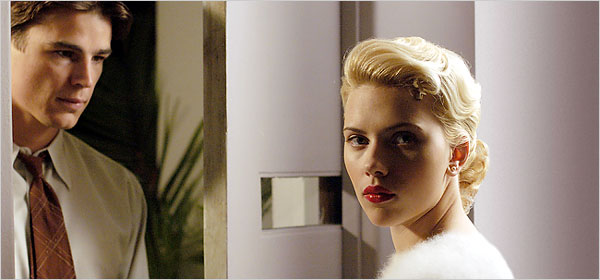Noir Overkill: Brian DePalma’s The Black Dahlia

“Nothing stays buried forever,” muses officer Bucky Bleichert in Brian De Palma’s overheated adaptation of the James Ellroy novel The Black Dahlia. He was speaking of hidden crimes, but he could have been meditating on the perennial resurgence of film noir conventions. Some would say the only genre completely invented by the movie industry, film noir reflected disillusionment after World War II and its heyday was in the 1940s and 50s. Starting with such classics as Double Indemnity and The Maltese Falcon, the genre conveyed a new cynicism about modern life where the hero often failed, the women were usually seductively deadly, and everyone moved in a nighttime world of cigarette smoke, Venetian blinds, and crime-filled city backdrops oozing corruption. Attracted to the genre’s creative possibilities, recent directors keep trying to resurrect the form with varying success. Recently, Rian Johnson figured out a way to successfully graft the genre onto a California high school in Brick, but other films such as Lucky Number Slevin show the drawbacks of mimicking such well-worn conventions—the films end up being drearily conventional.
Directed by well-respected Brian De Palma, Black Dahlia begins well in evoking the rough and tumble world of 1940s Los Angeles. I read Ellroy’s novel recently, and I especially enjoyed the way policemen back then did not really have to follow procedure all that carefully, and the novel evokes a mood of decadent romantic obsession with the brutally murdered Elizabeth Short. In real life, Short was cut in half, her body found in a field, and the resulting media storm rivaled the one generated by the murder of O. J. Simpson’s wife. Out of such materials, Ellroy concocted a very cinematic novel about two policemen who both become obsessed over the dead woman as they also compete for the affections of Kay Lake (Scarlet Johansson), a former prostitute who lives with Officer Lee Blanchard (Aaron Eckhart). Josh Hartnett plays the lead cop Bleichert, and for awhile one can take pleasure in the film’s evocation of zoot-suited gangsters, boxers, and lesbian bars where the likes of K. D. Lang sings torch songs. DePalma includes several ambitious set-piece scenes, notably one where a crane shot moves over the top of a building to focus briefly on the murdered woman in the distance before the camera tracks back around to a shoot-out on a city street after an all-night stakeout. Throughout his career, De Palma has suffered criticism for overtly stealing from Alfred Hitchcock, and he does lift a scene from Hitchcock’s “Vertigo” almost exactly when Bleichert finds himself unable to move up a square staircase in time to save a man in danger up above.
For awhile, with Scarlet Johansson looking sultry, the film works well enough, even if the sets oddly resemble those in an old Batman movie, but ultimately the screenwriter crams too many bloody and/or sexual incidents from the much longer plotted novel into its two hours of screen time. For all of De Palma’s expertise, The Black Dahlia views like a parody of too many superior 1940s films. I have nothing against Josh Hartnett as a leading man, but as he lights cigarette after cigarette and curls up in bed with Hilary Swank who plays the rich brat Black Dahlia look-alike Madeleine Linscott, one gets the feeling that both actors lack the gravitas to pull off such decadent passion. Where the book is smoldering and obsessed, the movie comes across as over-stuffed with perversity and histrionics.
Part of the problem lies in the character of Elizabeth Short herself (Mia Kirshner) who occasionally makes appearances in screen tests pieced together by the detectives. Short is basically a no-talent actress wannabe who sleeps with many military men (at one point Blanchard jokes that now they have only the entire US armed forces as suspects for the murder). In the book, she retains some mystery, but in De Palma’s recreation of the footage, she comes off as a disappointingly bland figure to get obsessed about. Sometimes, when it comes to crime and passion, less is more. In the tradition of Sin City, De Palma keeps pouring on the next mutilation, strangulation, and twisted fascination with “touching dead things.” By piling it on, The Black Dahlia ends up caricaturing the mood of the novel. I prefer film noir neat, with greater restraint, less blood splattered on the Venetian blinds.


Comments